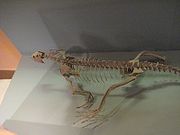
Trilophosaur
Encyclopedia
Trilophosaurs were lizard-like Triassic
diapsid
reptile
s related to the archosaur
s. The best known genus
is Trilophosaurus
, a herbivore
up to 2.5 meters long. It had a short, unusually heavily-built skull, equipped with massive, broad flattened cheek teeth with sharp shearing surfaces for cutting up tough plant material. Teeth are absent from the premaxilla
and front of the lower jaw, which in life were probably equipped with a horny beak.
 The skull is also unusual in that the lower temporal opening is missing, giving the appearance of a euryapsid
The skull is also unusual in that the lower temporal opening is missing, giving the appearance of a euryapsid
skull, and originally the Trilophosaurs were classified with placodont
s and sauropterygia
. Carroll 1988 suggests that the lower opening may have been lost to strengthen the skull.
Trilophosaurs are so far known only from the Late Triassic
of North America and Europe.
Triassic
The Triassic is a geologic period and system that extends from about 250 to 200 Mya . As the first period of the Mesozoic Era, the Triassic follows the Permian and is followed by the Jurassic. Both the start and end of the Triassic are marked by major extinction events...
diapsid
Diapsid
Diapsids are a group of reptiles that developed two holes in each side of their skulls, about 300 million years ago during the late Carboniferous period. Living diapsids are extremely diverse, and include all crocodiles, lizards, snakes, and tuatara...
reptile
Reptile
Reptiles are members of a class of air-breathing, ectothermic vertebrates which are characterized by laying shelled eggs , and having skin covered in scales and/or scutes. They are tetrapods, either having four limbs or being descended from four-limbed ancestors...
s related to the archosaur
Archosaur
Archosaurs are a group of diapsid amniotes whose living representatives consist of modern birds and crocodilians. This group also includes all extinct non-avian dinosaurs, many extinct crocodilian relatives, and pterosaurs. Archosauria, the archosaur clade, is a crown group that includes the most...
s. The best known genus
Genus
In biology, a genus is a low-level taxonomic rank used in the biological classification of living and fossil organisms, which is an example of definition by genus and differentia...
is Trilophosaurus
Trilophosaurus
Trilophosaurus was a lizard-like Triassic diapsid reptile related to the archosaurs. It was a herbivore up to 2.5 meters long. It had a short, unusually heavily-built skull, equipped with massive, broad flattened cheek teeth with sharp shearing surfaces for cutting up tough plant material...
, a herbivore
Herbivore
Herbivores are organisms that are anatomically and physiologically adapted to eat plant-based foods. Herbivory is a form of consumption in which an organism principally eats autotrophs such as plants, algae and photosynthesizing bacteria. More generally, organisms that feed on autotrophs in...
up to 2.5 meters long. It had a short, unusually heavily-built skull, equipped with massive, broad flattened cheek teeth with sharp shearing surfaces for cutting up tough plant material. Teeth are absent from the premaxilla
Premaxilla
The incisive bone is the portion of the maxilla adjacent to the incisors. It is a pair of small cranial bones at the very tip of the jaws of many animals, usually bearing teeth, but not always. They are connected to the maxilla and the nasals....
and front of the lower jaw, which in life were probably equipped with a horny beak.

Euryapsida
Euryapsida is a polyphyletic group of reptiles that are distinguished by a single temporal fenestra, an opening behind the orbit, under which the post-orbital and squamosal bones articulate. They are different from Synapsida, which also have a single opening behind the orbit, by the placement of...
skull, and originally the Trilophosaurs were classified with placodont
Placodont
Placodonts were a group of marine reptiles that lived during the Triassic period, becoming extinct at the end of the period. It is believed that they were part of Sauropterygia, the group that includes Plesiosaurs...
s and sauropterygia
Sauropterygia
Sauropterygia were a group of very successful aquatic reptiles that flourished during the Mesozoic before they became extinct at the end of the era. They were united by a radical adaptation of their shoulder, designed to support powerful flipper strokes...
. Carroll 1988 suggests that the lower opening may have been lost to strengthen the skull.
Trilophosaurs are so far known only from the Late Triassic
Late Triassic
The Late Triassic is in the geologic timescale the third and final of three epochs of the Triassic period. The corresponding series is known as the Upper Triassic. In the past it was sometimes called the Keuper, after a German lithostratigraphic group that has a roughly corresponding age...
of North America and Europe.

